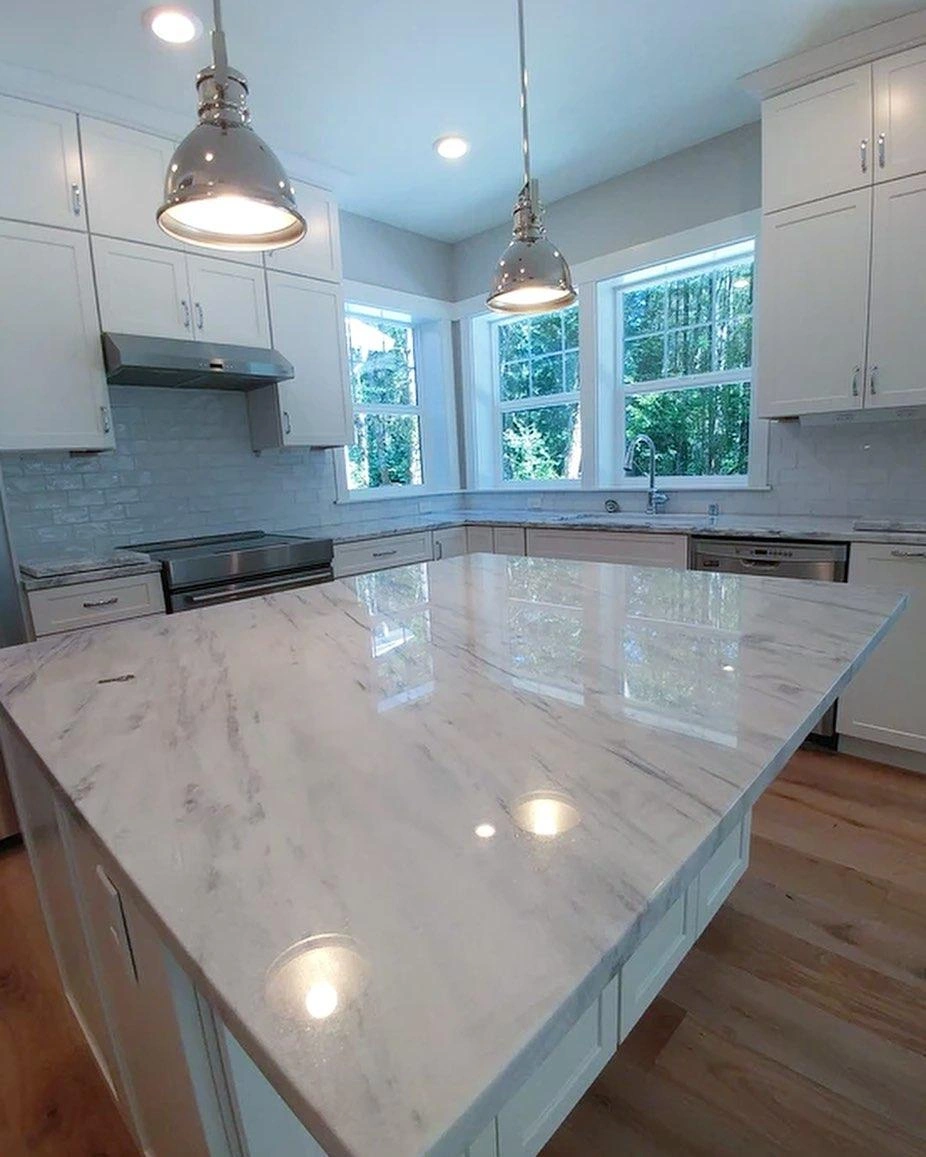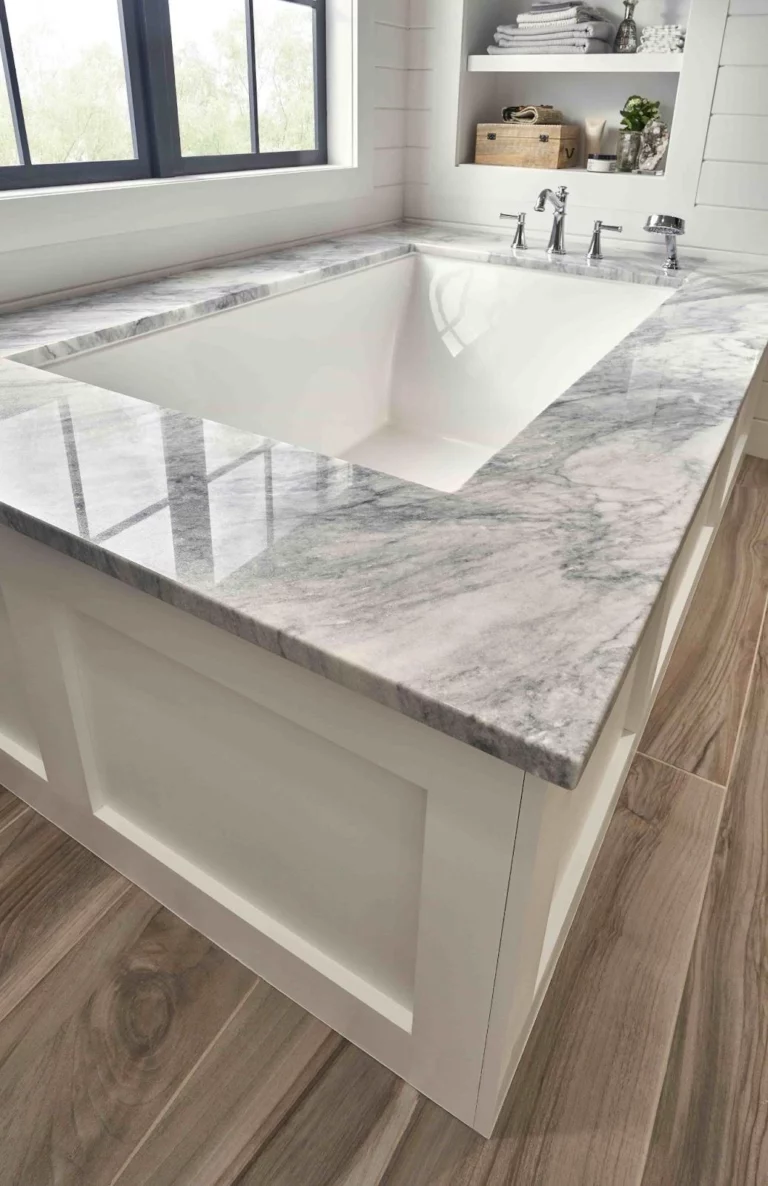If you already know that marble countertops need extra care, you’re ahead of the curve. Marble requires regular sealing, safe cleaning products, and quick attention to every spill to stay in its best condition. Acidic substances like lemon juice or vinegar can etch, and oil-based spills can leave lasting stains.
That’s why prevention matters as much as design. At Tops Countertops, we specialize in marble protection, helping homeowners seal marble countertops and clean and maintain them with confidence.
Why Do Marble Countertops Stain Easily?
Marble countertops are beautiful, but they come with a reality many homeowners underestimate: marble is porous. Unlike some other natural stone countertops, a marble surface will readily absorb water and oil, making it prone to staining if left unprotected. Without a quality sealer, even a small spill can soak in and leave a permanent mark.
The most common offenders are everyday items, like red wine, coffee, lemon juice, tomato sauce, and cooking oils. These can cause organic stains or visible water spots that disrupt the natural elegance of marble.
It’s also important to separate etching from staining. A stain is caused by absorption, while etching is chemical damage from acidic substances like vinegar or citrus. Etching leaves a dull, rough patch on the marble top, which requires a different repair process than a stain.
Because natural marble countertops stain easily and are susceptible to scratches, prevention is key. If you want to protect your investment and keep your kitchen countertops in the best condition, you need to understand these vulnerabilities before they turn into costly repairs.
Proven Ways to Prevent Staining on Marble Countertops

Preventing stains on marble countertops is less about complicated techniques and more about consistent care. Since marble is porous, it requires the right combination of sealing, cleaning, and everyday habits to keep your marble surface in top condition. Here’s how to do it.
1. Seal Regularly and Properly
The first and most important step in marble protection is sealing. Always seal marble countertops with a high-quality marble sealer. This process helps impregnate the stone, creating a barrier that repels water and oil-based spills before they can sink in.
Most fabricators recommend you seal your marble every 6 months in active kitchens, though lighter-use areas may stretch longer. To know if it’s time, perform a simple test: place a few drops of water on the surface. If the water darkens the stone, it’s time to reseal your countertop.
Choose an impregnating sealant specifically designed for natural stone countertops. Generic sealers or waxes won’t offer the same oil-repellent protection and may leave residues that interfere with proper sealing. The best products are those designed for marble care, not one-size-fits-all solutions.
2. Wipe Spills Immediately and Use the Right Tools
Even sealed stone isn’t invincible. Spills left to sit on a marble countertop can still soak in and cause organic stains or etching. Always blot, never wipe. Use a soft cloth or microfiber cloth to absorb liquid without spreading it further.
For regular cleaning, use a pH-neutral stone cleaner or warm water mixed with a drop of mild soap. Avoid harsh or acidic cleaning products like vinegar, lemon juice, or ammonia. These don’t just fail to clean your marble; they actively etch the surface, dulling the shine.
Dry surfaces with a soft cloth after cleaning to prevent water spots. With consistent practice, these small habits make it easy to clean and maintain your marble in its best condition.
3. Everyday Habits That Protect Marble
The best defense against stains and scratches isn’t just what you clean with; it’s how you use your kitchen.
- Cutting boards: Always prep food on a board. Knives can scratch and leave marks on your marble tops.
- Trivets: Place hot pans on trivets instead of directly on the countertop to avoid thermal shock and discoloration.
- Trays and coasters: Keep oils, condiments, and soap bottles on trays to contain drips and prevent oil-based stains.
- Mix materials strategically: If your kitchen gets heavy daily use, consider combining marble tops with more durable kitchen countertops like quartz in high-traffic zones. This way, you get the elegance of marble without overexposing it.
These habits protect your marble investment, ensuring it continues to add beauty without becoming a maintenance burden.
4. Stain Removal Basics if Prevention Fails
Even with the best care, accidents happen. When they do, knowing how to remove stains quickly is essential.
- Poultice method: For oil-based stains, apply a poultice of baking soda and water. For organic stains like coffee or wine, mix baking soda with hydrogen peroxide. Spread it over the stain, cover with plastic wrap, and let it sit 24–48 hours before wiping clean.
- Acetone: For certain stubborn marks, acetone can act as a safe stain remover, but always test a small area first.
- Professional help: If stains persist, consult your fabricator or follow Natural Stone Institute guidelines to avoid causing further damage.
- Added protection: In high-traffic kitchens, consider applying protective films like TuffSkin. They act as a shield, preventing stains and scratches while keeping your marble’s natural look.
When you know how to act fast with the right removers and best products, you can protect your marble from permanent damage and keep it looking its best for years.
Ready to Protect Your Marble Countertops for Years to Come?
Your marble investment deserves more than guesswork. At Tops Countertops, our team can guide you on the best products, proper sealing schedules, and long-term marble care strategies.
Visit our Design Center to explore marble tops in person, schedule a consultation, or ask about professional sealing services.
With expert help, you can seal your countertop, keep your marble countertop in its best condition, and protect your marble so it continues to shine for years.
FAQs About Preventing Marble Stains
How often should I seal marble countertops?
Most experts recommend you seal marble countertops every 6 to 12 months, depending on how often the kitchen is used. High-traffic kitchens may require sealing more frequently to maintain protection.
What’s the best way to remove stains from a marble surface?
To safely remove stains, start by identifying the source. For oil-based stains, use a poultice with baking soda and water. For organic stains, baking soda with hydrogen peroxide works well. Always avoid harsh or acidic chemicals.
Can I use a baking soda poultice to lift oil-based stains?
Yes. A baking soda poultice is one of the safest, most effective methods to lift oil-based stains from a marble surface. Apply it to the stain, cover with plastic, and let it sit for 24–48 hours before cleaning.
What’s the difference between an etch and a stain on marble?
A stain occurs when marble absorbs liquid, while an etch is surface damage caused by acidic substances like lemon juice or vinegar. Etching leaves dull marks and requires polishing, while stains need a stain remover or poultice.
Are polished marble countertops less prone to staining than honed ones?
Yes. Polished marble countertops have a smoother finish, making them somewhat less prone to staining. However, both polished and honed surfaces are still porous and need sealing and regular marble care.
Which cleaning products are safe for marble care, and which should I avoid?
For daily cleaning, use a pH-neutral stone cleaner or warm water with a mild soap. Avoid acidic cleaning products like vinegar, citrus, or ammonia; they cause etching. Always stick to cleaning products labeled safe for natural stone.
